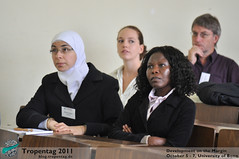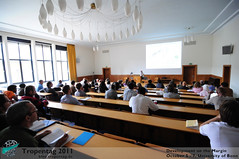international research
CIAT celebrates its 45 years anniversary
Sat, 09/22/2012 - 14:30 — De-Registered User
Tropentag 2012 hosts an oral session dedicated to the International Center for Tropical Agriculture (CIAT).
The title of the session from CIAT is “soil and resilience".In the session, five scientists from CIAT presents various aspects of research on soils and resilience.
For the one that did not attain the session, the following video is an exclusive interview of Dr. Bossio. For you, she highlights the main message the session tries to convey.
To read more on the content of the presentations, click on one of the following title:
Domestication of soil variability in Sub-Saharan Africa: Almost there (Job Kihara's presentation)
Quesungual Slash and Mulch Agroforestry System (QSMAS): provider of ecological services (Aracely Castro's presentation)
Prevent irreversible degradation of agro-ecoystem in Amazonia now! (Patrick Laville's presentation
This year Mrs. Bossio is one of the key note speakers. She conveys an interesting message on soil management practice. For more details and a second interview of her, click on the following link: Soil is back on the agenda.
Stuck under the Weather
Wed, 10/19/2011 - 10:10 — De-Registered User
A short film depicting impacts of the Orissa Floods on land and livelihoods by Dr. Joe Hill (Tropentag October 6, 2011).
The Cyclone warnings on the radio were only sent out hours before it hit. The people of Orissa suffered significant losses and after the storm resided, their only resort was to salvage rice and coconut water. Relief aid only came 4-5 days later. This can almost be seen as an regular scenario in Orissa. Farmers have no land of their own, and if they do it's not fertile to grow enough. Farmers are also aware of their fertilizer use degrading their land fertility, but they have no choice despite the fact that it could cause the next floods to be even worse. Many farmers have resorted to fishing in order to survive but this too is not enough. While cyclones and floods wipe out any coastal aquatic life, industrial fishing in deep waters outside Orissa significantly reduce fish numbers coming into the coast, significantly reducing local fishermen's catch. On land, there is a lack of water and a lack of work.
"Every day is a struggle to make ends meet."
The Seeds of the Future
Tue, 10/11/2011 - 09:56 — De-Registered User
The thematic session on Crop Biotic Stresses on Friday 7 October, 2011 touched upon various research into crop production and crop management methods. While the results were also unique, the discussions at Tropentag focused their interest on the improvement of methodologies.
The impacts of crop management.
The session looked at the effects of Chlorpyrifos in Costa Rica and how they are having a negative impact on the children in the area. The exposure came from the use of Chlorpyrifos-bags used in banana and plantain Plantations. We were also introduced to the research through a microarray analysis of gene expression induced in tomato leaves. The genes were compared between treated/untreated/diseased/healthy tomato plants and observed for activation of plant resistance. Interestingly enough, someone in the crowd commented on the research and arrived at opposite results having done the same research. The debate was left up in the air… to be continued during the following coffee break.
 Fellow presenters listening to their colleague's presentation.
Africa stricken with Striga!
Fellow presenters listening to their colleague's presentation.
Africa stricken with Striga!
 Fellow presenters listening to their colleague's presentation.
Africa stricken with Striga!
Fellow presenters listening to their colleague's presentation.
Africa stricken with Striga!
To Feed or not to Feed?
Fri, 10/07/2011 - 11:25 — De-Registered User
The Tropentag 2011 Thematic Presentations on Animal Production Systems discuss various trade-offs between different animal feeds and feeding practices. The livestock in question ranged from cattle to shrimp and even guinea pigs!
 Presentations on Animal Production Systems at Tropentag 2011.
Transforming to Integrated Ecosystems
The common thread through all the presentations was how to integrate livestock production into the natural environment. Sustainable aquaculture that aims at minimizing impact on the environment can in the long run provide farmers with much better livelihoods. We were presented with some great use of Google map imaging depicting the boundaries of land usage and how livestock production can be integrated without degrading the environments around it. A ratio between environmental land coverage and live stock land usage enforces the ongoing theme of 'doing more with less'.
Presentations on Animal Production Systems at Tropentag 2011.
Transforming to Integrated Ecosystems
The common thread through all the presentations was how to integrate livestock production into the natural environment. Sustainable aquaculture that aims at minimizing impact on the environment can in the long run provide farmers with much better livelihoods. We were presented with some great use of Google map imaging depicting the boundaries of land usage and how livestock production can be integrated without degrading the environments around it. A ratio between environmental land coverage and live stock land usage enforces the ongoing theme of 'doing more with less'.
 Presentations on Animal Production Systems at Tropentag 2011.
Transforming to Integrated Ecosystems
The common thread through all the presentations was how to integrate livestock production into the natural environment. Sustainable aquaculture that aims at minimizing impact on the environment can in the long run provide farmers with much better livelihoods. We were presented with some great use of Google map imaging depicting the boundaries of land usage and how livestock production can be integrated without degrading the environments around it. A ratio between environmental land coverage and live stock land usage enforces the ongoing theme of 'doing more with less'.
Presentations on Animal Production Systems at Tropentag 2011.
Transforming to Integrated Ecosystems
The common thread through all the presentations was how to integrate livestock production into the natural environment. Sustainable aquaculture that aims at minimizing impact on the environment can in the long run provide farmers with much better livelihoods. We were presented with some great use of Google map imaging depicting the boundaries of land usage and how livestock production can be integrated without degrading the environments around it. A ratio between environmental land coverage and live stock land usage enforces the ongoing theme of 'doing more with less'.




